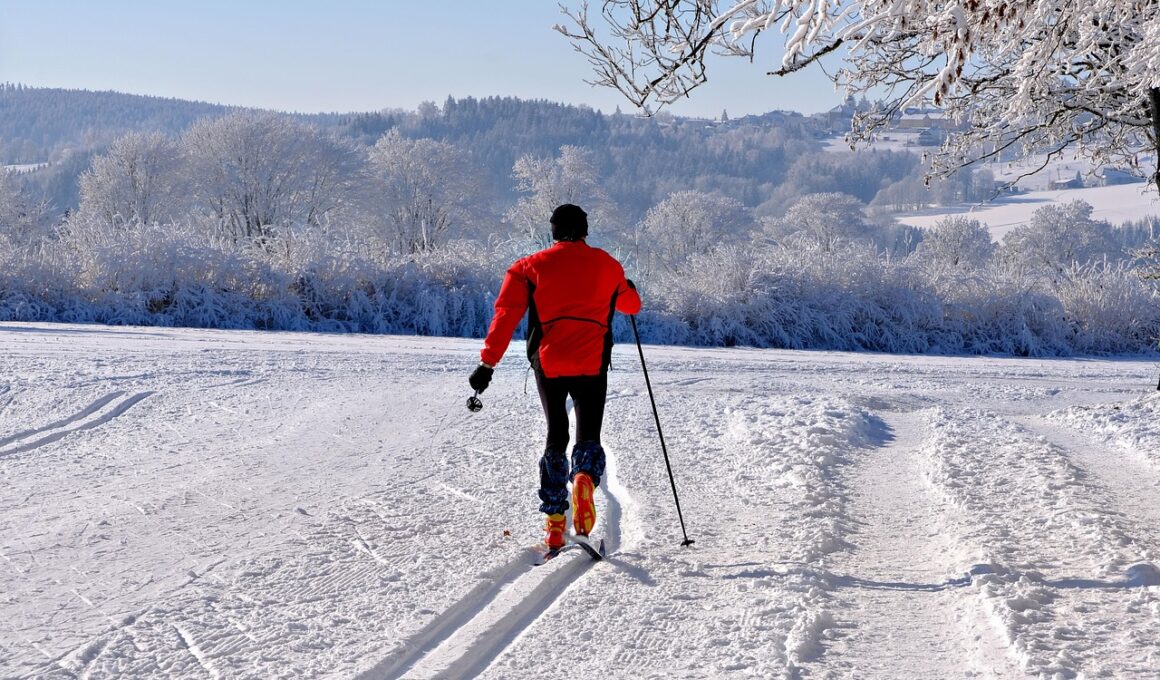Understanding the Physiological Effects of Cold Exposure Therapy
Cold exposure therapy has gained attention as an innovative practice within the fitness industry. Enthusiasts utilize this technique to enhance recovery and improve performance. When individuals expose their bodies to cold temperatures, physiological responses occur that are increasingly recognized. Cold exposure causes vasoconstriction, reducing blood flow to extremities, thus promoting efficient nutrient and oxygen distribution to vital organs. Moreover, this process can decrease inflammation, which often inhibits muscle recovery. The therapy is believed to stimulate recovery through decreased muscle soreness and improved circulation. Additionally, cold exposure can enhance mood and reduce stress levels, contributing positively to mental clarity. Athletes are finding this approach beneficial for reducing anxiety and improving focus during training sessions. Various methods exist for cold exposure, including cryotherapy chambers, ice baths, and local cold packs. Safety is paramount, so individuals should gradually introduce cold therapy into their routines. Regular practice is crucial for achieving optimal benefits, making persistence key to successful adaptation. Cold exposure represents a fusion of science and fitness, as more people explore its numerous advantages. Understanding its physiological effects helps fitness enthusiasts make informed decisions about incorporating it into their routines.
Enhanced Recovery and Muscle Function
The primary benefit of cold exposure therapy is its significant role in enhancing recovery and muscle function. As muscles endure strain during intense workouts, microtears occur, leading to delayed onset muscle soreness (DOMS). Cold exposure aids in minimizing DOMS by shifting the inflammatory response. Reduced inflammation mitigates pain, enabling quicker return to peak performance levels. Evidence suggests that post-exercise cold exposure helps to stabilize muscle temperature, which may contribute to muscle preservation. Through thermal regulation, muscles maintain their strength and endurance capabilities even after rigorous training. Additionally, cooldown practices like ice baths are widely adopted by athletes for swift recovery. By contrasting high-intensity workouts with cold exposure, athletes can harness physiological responses that heighten their overall training effect. Research supports enhanced circulation as a direct benefit to cold exposure therapy, flushing metabolic waste products from the muscles. The integrative approach of timing cold exposure with exercise could provide lasting advantages. However, determining the optimal duration and intensity varies among individuals, requiring personalized protocols. Cold exposure therapy exemplifies how targeted recovery approaches can strategically influence athletes and fitness enthusiasts to reach their maximum potential sooner.
Enduring cold exposure can act as an unforeseen ally in dealing with fatigue and promoting mental resilience. It challenges the mind and body, leading to numerous adaptive responses. For many fitness enthusiasts, the discomfort of cold therapy cultivates mental toughness and emphasizes the importance of overcoming obstacles. Practicing cold exposure often translates to improved discipline, indirectly benefiting overall fitness regimens. The psychological benefits go beyond mere physical recovery; many individuals report elevated moods and reduced stress levels post-therapy. The rush of endorphins released during cold exposure can lead to feelings of euphoria, making it an attractive proposition for those struggling with anxiety. The practice encourages mindfulness, as individuals must remain present while facing discomfort. The benefits extend to various aspects of health, creating a holistic impact on mental and emotional well-being. Fitness enthusiasts are encouraged to incorporate breathing techniques during therapy sessions, further enhancing mindfulness. Collectively, these advantages create an environment conducive to growth and improved performance. This multifaceted approach exemplifies the intersection of physical and psychological wellness, reinforcing the compelling case for including cold exposure therapy in fitness routines.
Cold Shock Proteins and Adaptation
As individuals engage with cold exposure therapy, fascinating phenomena such as cold shock proteins are activated, contributing significantly to adaptive processes within the body. These proteins serve vital functions, such as protecting cells and promoting muscle growth. Cold shock proteins trigger the release of heat shock proteins that mitigate cellular damage caused by physical stressors. The activation of these proteins aids in muscle repair, thereby enhancing overall resilience against injuries and strains. Furthermore, regular cold exposure is believed to induce metabolic adaptations, signaling the body to optimize energy production processes. This metabolic improvement can enhance endurance and overall athletic performance. Engaging with such temperature extremes sends a powerful message to our cells, promoting robust adaptations and physiological resilience over time. Consequently, individuals building a consistent relationship with cold exposure therapy may experience transformative changes, reflected through improved stamina and power. This physiological response forms a core part of contemporary strategic training methods. As scientific research advances, exploring cold shock proteins can unlock new insights into elite performance enhancement techniques. Consequently, fitness enthusiasts seeking an edge might consider integrating cold exposure into their training regimens for maximal results.
Practical applications of cold exposure therapy have emerged, attracting fervent curiosity within fitness circles. Many athletes and trainers now emphasize tailored programs to maximize benefits. Notably, its incorporation into warm-up and cooldown routines is gaining popularity. Ice baths are commonly employed post-training or competition to harness cold exposure’s advantages efficiently. However, individual preferences and tolerances dictate how cold exposure effectively fits into one’s regimen. Some may prefer localized applications, such as cold packs, while others may opt for more immersive experiences like cryotherapy. The duration and temperature of exposure can also be personalized, ensuring optimal adaptations specific to training goals and existing physical conditions. Additionally, fitness facilities are increasingly equipped with specialized cold exposure equipment, making it more accessible for participants. As practitioners continue to explore cold exposure’s many techniques, the potential for discovery expands. Instructors can further assist individuals by educating them on practical implementations, enhancing peer engagement, and encouraging community participation. As the fitness community continues adapting, knowledge and understanding about cold exposure therapy can evolve, fueling enthusiasm and curiosity for mastering this innovative recovery technique.
Precautions and Considerations
While cold exposure therapy offers remarkable benefits, certain precautions and considerations must be observed. First, understanding one’s body and health limitations is critical when engaging in any new fitness modality. Individuals should consult with healthcare professionals, especially if pre-existing conditions are present. Those with cardiovascular issues, respiratory conditions, or skin sensitivities should approach cold exposure with caution. Additionally, the duration and intensity of exposure must be carefully balanced, as maintaining a safe temperature is paramount. Gradual acclimatization is advised, slowly introducing cold exposure into routines. Maintaining warmth when emerging from cold exposure is equally crucial, as rapidly transitioning to warmth can be shocking to the system. Lastly, recovery should not be rushed; allowing ample time per session ensures physiological benefits are maximized and achieved effectively. Implementing these safety protocols nurtures a balanced environment where athletes can safely pursue their goals without risking adverse effects. Being cautious allows individuals to experience all the advantages cold exposure can bring while ensuring safety remains a priority. By raising awareness about these considerations, a more informed and health-conscious approach to cold exposure therapy can flourish within the fitness community.
Research on cold exposure therapy is expanding steadily, underscoring its relevance in the fitness industry. Scientific studies continue exploring its physiological effects, benefits, and long-term implications. This research validates the credibility of cold exposure in fitness, enhancing practitioners’ and participants’ trust in the practice. Experimentation and exploration into different modalities inform safer, more efficient approaches. Additionally, future studies could reveal new applications, further enhancing athletic performance and recovery. As athletes continue to share personal anecdotes highlighting successful implementations, the community is motivated to contribute its knowledge and engage with cold exposure practices. Social media platforms amplifying these experiences encourage collective curiosity, fostering a dialogue between enthusiasts seeking optimal performance. Moreover, educators and trainers are encouraged to stay informed about emerging findings in cold exposure therapy. Regularly incorporating this knowledge can enrich programs, empowering fitness enthusiasts to explore innovative paths. The feedback loop created by research and practical application makes cold exposure therapy an exciting focal point in fitness. Continued dedication to understanding its effects and benefits can unlock pathways for broadening its influence within the fitness landscape over time. Ultimately, both research and practical experiences complement one another, redefining fitness and recovery concepts.
In conclusion, cold exposure therapy presents a multitude of potential physiological benefits within the fitness industry framework. Embracing this trend signifies a growing recognition of holistic approaches to wellness, emphasizing recovery and performance enhancement. The integration of scientific research and practical experience enriches understanding, allowing for informed decision-making for those considering its adoption into fitness regimens. Moreover, fitness professionals play a pivotal role in guiding and educating individuals about the nuances of cold exposure therapy. Providing clear protocols and recommendations ensures participants achieve meaningful results while staying safe. Individuals committed to exploring cold exposure will continue to promote its importance, establishing it as an integral part of fitness culture. As trends evolve, further innovations may arise, breathing new life into recovery practices. Cold exposure therapy encapsulates a contemporary response to the challenges faced in fitness, presenting an avenue for improving overall health and well-being. The collective focus on physical, mental, and emotional aspects aligns with the holistic model of fitness that prioritizes balance, resilience, and performance optimization. Ultimately, cold exposure therapy becomes a testament to the evolution of fitness practices and their commitment to advancing human potential.


